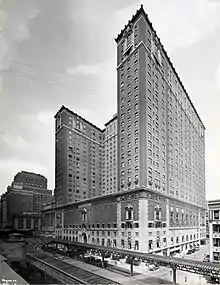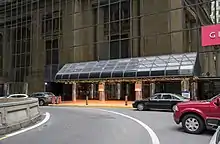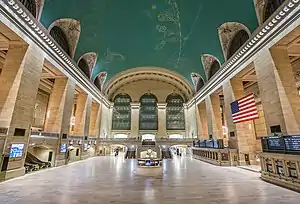Grand Hyatt New York
The Grand Hyatt New York is a hotel located directly east of the Grand Central Terminal in Midtown Manhattan, New York City. Originally named The Commodore Hotel, it opened on January 28, 1919. In 1980, then real estate entrepreneur and construction magnate Donald Trump initiated a major renovation which encased the outside of the building in glass and renovated the inside as part of his first construction project in Manhattan. The hotel's demolition and replacement was announced in February 2019.
| Grand Hyatt New York | |
|---|---|
 The facade of Grand Hyatt New York as seen from the southeast, at Lexington Avenue and 42nd Street | |

Interactive map highlighting the hotel's location | |
| Hotel chain | Hyatt Hotels |
| General information | |
| Location | Manhattan, New York |
| Address | 109 East 42nd Street |
| Coordinates | 40°45′07″N 73°58′35″W |
| Opening | January 28, 1919 |
| Renovated | September 25, 1980 |
| Demolished | 2022 (expected) |
| Owner | Hyatt |
| Management | Hyatt |
| Height | 295 ft (90 m) |
| Technical details | |
| Floor count | 26 |
| Design and construction | |
| Architect | Warren & Wetmore |
| Renovating team | |
| Architect | Gruzen Samton |
| Other information | |
| Number of rooms | 1306 |
| Website | |
| https://newyork.grand.hyatt.com/ | |
History
Commodore Hotel
The Commodore Hotel was constructed by the Bowman-Biltmore Hotels group. The structure itself was developed as part of "Terminal City", a complex of palatial hotels and offices connected to Grand Central Terminal and all owned by the New York State Realty and Terminal Company (NYSRTC), a division of the New York Central Railroad (NYCRR). The Commodore was named after "Commodore" Cornelius Vanderbilt, the founder of NYCRR; a statue of Vanderbilt is located outside the hotel. The Commodore was designed by Warren & Wetmore and leased by the NYSRTC to the Bowman-Biltmore Hotels Corporation, of which John McEntee Bowman was president.[1]

The Commodore opened on January 28, 1919. Herbert R. Stone, of NYSRTC, oversaw the decor of its 2,000 rooms. The lobby, called the "Most Beautiful Lobby in The World," was the single largest room in the hotel, with modern low ceilings and a waterfall designed by John B. Smeraldi. A group of conventioneers once told Bowman that "New York City was like a circus," so the next day Bowman, ever a showman, arranged to place a circus, complete with elephants, in the grand ballroom. Another popular spot was the Century Room, which boasted its own orchestra. The Commodore shared a parking garage with its sister hotel, the New York Biltmore Hotel, which had been Bowman-Biltmore's first hotel investment.[1] Another Terminal City property – The Roosevelt Hotel, originally a United Hotel asset – merged with Bowman-Biltmore Corporation on March 4, 1929, giving Terminal City access to all railroad passenger traffic in and out of New York City. One notable person to have stayed at The Commodore was Albert Einstein, who stayed at the hotel for a few weeks in April 1921 during his tour of the east coast of the U.S. promoting the creation of Hebrew University in Jerusalem.
The Commodore was successful for decades, and in June 1967, NYCRR – which by then was running the hotel through a division called Realty Hotels – upgraded the Commodore with a 3.4 million-dollar refurbishment. On May 10, 1972, while John R. Garside was the hotel's general manager, the Commodore became the first hotel in New York City to show in-room movies through Player Cinema Systems. However, by the late 1970s, both the railroad (now Penn Central, following merger with the Pennsylvania Railroad) and the hotel had become less successful. On May 11, 1977, the now-bankrupt railroad's asset manager, Victor Palmieri, told the city that the Commodore had lost $1.5 million in 1976 and might have to be shuttered.
At that point, Donald Trump reached an option agreement with Penn Central to purchase the Commodore.[2][3] Trump, however, did not have the $250,000 necessary to secure the option.[2][4] Nevertheless, Trump's father, Fred Trump, had a long time political connection through the Brooklyn Democratic machine to then-Mayor Abraham Beame.[4] Despite the city being in the midst of the worst fiscal crisis in its history, Beame's deputy mayor, Stanley Friedman, pushed through a 40-year, $400 million tax abatement on the property.[4] Asked by city officials to supply a copy of the agreement with Penn Central, Trump sent the option agreement paperwork minus the signatures.[2] The abatement moved forward as if the agreement had been signed and as if Trump had paid to secure the option.[2] Trump was then able to convince the Hyatt hotel chain to partner with the Trump Organization and purchase the Commodore.[2]
Conversion into Grand Hyatt

The Trump Organization rebuilt the hotel at a cost of US$100 million, gutting the first few floors of the interior down to their steel frame (although the same basic layout of public rooms was retained) and placing a new reflective glass facade on top of the existing masonry exterior. The work was done by the firm of Gruzen Samton,[5] with architect Der Scutt, who would later design Trump Tower, serving as design consultant.[6] The only portion of the hotel's decor left untouched was the foyer to the grand ballroom, with its neoclassical columns and plasterwork.
The hotel re-opened on September 25, 1980,[7] as the Grand Hyatt New York, with Governor of New York Hugh Carey and Mayor of New York City Ed Koch in attendance. The new facade was criticized as out of place and as having destroyed the character of East 42nd Street. The Architectural Guidebook to New York City referred to the facade as a “mirror box” and an “utter and inexcusable outrage.”[8] The Guidebook continued:
The old Commodore was a brick and masonry structure of appropriately modest and deferential design. The Grand Hyatt imposes its garish vacuity with a painful lack of concern about the way it relates to one of the most architecturally significant streets in America.[8]
In 1989, New York State officials ordered the hotel to pay New York City $2.9 million in rent that had been withheld by the hotel in 1986 due to "unusual" accounting changes approved by Donald Trump.[9] An investigation by New York City auditors noted that the hotel was missing basic financial records and found that the hotel was using procedures that violated Generally Accepted Accounting Principles.
The Trump/Hyatt partnership eventually collapsed, with Trump filing a civil racketeering suit against Hyatt owner Jay Pritzker on July 28, 1993, alleging that Hyatt had used improper accounting practices, in order to force Trump out of the partnership with Hyatt, which restricted the chain from operating any other convention hotel in New York City.[10] The Pritzkers countersued on March 28, 1994, alleging that Trump had violated their partnership by failing to remain solvent, using his share in the hotel as collateral for bank loans, and refusing to cover his share of the cost of necessary repairs.[11] The much-needed renovation of the hotel finally began on April 8, 1996, and continued through that August.[12] Finally, on October 7, 1996, the Pritzkers bought Trump's half-share in the hotel for $142 million, ending the partnership.[13][14]
The hotel won the 2007 and 2008 Corporate and Incentive Travel magazine "Award of Excellence." It was completely renovated in 2011, at a cost of $130 million, at which point the 1980s modern interiors were removed.[15] The renovation was complicated by the structure's 1919 origins, including 138 different guest-room configurations.
Project Commodore
The replacement of the Grand Hyatt New York hotel was announced in February 2019. The hotel will be demolished as part of a project by TF Cornerstone and MSD Partners, subject to the approval of the state and the city, though no final agreement had been signed. A new 2,600,000-square-foot (240,000 m2) mixed-use structure with office and retail space, as well as a smaller hotel, would be built on the site.[16] The development would require transfer of the lease on the property from Hyatt, which holds it through 2077.[17]
In November 2020, preliminary plans for an 83-story mixed-use tower called Project Commodore were announced on the site of the Grand Hyatt New York. The tower, designed by Skidmore, Owings & Merrill, would be 1,646 feet (502 m) tall making it the second the tallest in New York City if completed. The structure would contain office space on the 7th through 63rd floors and a 500-room Grand Hyatt hotel on the 65th through 83rd floors.[18] The basement, first, and second floors would contain retail, while the first floor would also contain a transit hall leading to Grand Central Terminal and the New York City Subway's Grand Central–42nd Street station. A public plaza and a stair to the Park Avenue Viaduct would also be built. If approved the projected timeline for the project has 18 months for demolition and 47 months of construction with a preliminary completion date in 2030.[19] Preliminary preliminary renderings of the street levels of the tower and transit hall and design concept for the tower were released in February 2020. [20]
References
- "The World's Newest and Largest Hotels: The Hotel Pennsylvania and The Hotel Commodore". Architectural Review. VIII (3): 55. March 1919 – via Google Books.
- Rosenthal, Max J. (July 11, 2016). "The Trump Files: How Donald Tricked New York Into Giving Him His First Huge Deal". Mother Jones. Retrieved May 8, 2018.
- Traub, James (December 21, 2000). "Golden Boy". The New York Review of Books. Archived from the original on May 6, 2016. Retrieved November 5, 2018.
- Rich, Frank (April 29, 2018). "The Original Donald Trump". New York. Retrieved May 8, 2018.
- Trump, Donald (1987). The Art of the Deal. Warner Books. ISBN 978-0394555287.
- Bernstein, Fred A. (March 16, 2010). "Der Scutt, Modernist Architect, Dies at 75". The New York Times. Retrieved April 22, 2018.
- "Grand Hyatt Hotel Pictures". Getty Images. September 25, 1980. Retrieved April 22, 2018.
- Morrone, Francis (2009). The Architectural Guidebook to New York City. Gibbs Smith. ISBN 978-1586852115. Retrieved April 2, 2020.
- Kates, Graham (August 8, 2016). "Inside a Donald Trump audit: Missing books and unusual accounting". CBS News. Retrieved January 12, 2017.
- Henriques, Diana B. (July 29, 1983). "Trump Sues Pritzker As a Feud Goes Public". The New York Times. Retrieved April 22, 2018.
- Henriques, Diana B. (March 29, 1994). "COMPANY NEWS; Pritzker vs. Trump, and Vice Versa". The New York Times. Retrieved April 22, 2018.
- "Grand Hyatt announces multi-million dollar renovation". Real Estate Weekly. March 20, 1996. Archived from the original on April 7, 2017. Retrieved July 1, 2018.
- "The Grand Hyatt Hotel". The Trump Organization. Retrieved November 2, 2016.
- "Trump Sells Hyatt Share To Pritzkers". The New York Times. October 8, 1996. Retrieved November 2, 2016.
- Bernstein, Fred A. (January 11, 2011). "Grand Hyatt Makover Sheds the Trump Glitter". The New York Times. Retrieved April 22, 2018.
- Barbanel, Josh (February 7, 2019). "New York's Grand Hyatt Hotel to Be Torn Down". Wall Street Journal. Retrieved February 9, 2019.
- Plitt, Amy (February 7, 2019). "Midtown's Grand Hyatt Hotel to be replaced by huge mixed-use tower". Curbed NY. Retrieved February 9, 2019.
- "1,646-Foot-Tall Project Commodore Revealed, New York City's Possible New Tallest Building by Roof Height, in Midtown East". New York YIMBY. November 21, 2020. Retrieved November 21, 2020.
- "First Look at Grand Central Terminal's Grand Hyatt Hotel Replacement". Commercial Observer. February 2, 2021. Retrieved February 2, 2021.
- "1,600-Foot Tall Project Commodore Fully Unveiled, At 175 Park Avenue In Midtown East, Manhattan". New York NIMBY. February 4, 2021. Retrieved February 4, 2021.

